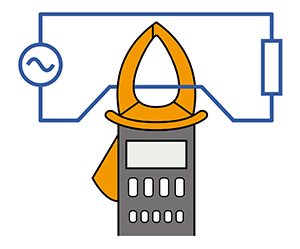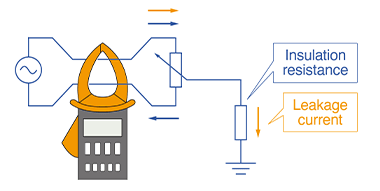Tips for Using Clamp Meters, Related Precautions, and more
Overview
To measure parameters like current and voltage, you’ll need a dedicated instrument. Instruments such as analog multimeters and digital multimeters are often used to measure current, but they require that the circuit be cut so that the instrument’s test leads can be inserted into the circuit in series. In many cases, it’s not possible or practical to do that. Cutting the circuit also poses risks, for example of electric shock.
Clamp meters are a convenient choice in such situations. This page offers a detailed explanation of how to use a clamp meter as well as related precautions.
What is a clamp meter?
A clamp meter is a clothespin-shaped instrument that can be clamped around a live wire in order to measure the current it’s carrying. As a measurement principle, clamp meters detect the magnetic field emitted by current flowing in a wire in order to measure the current value.
Unlike instruments like multimeters, this design has the advantage of being able to measure current without requiring that the circuit under measurement be cut. Broadly speaking, there are two types of clamp meter:
- Models designed to measure load current
- Models designed to measure leakage current
Instruments can be further classified based on other differences, for example whether they measure direct current (DC) or alternating current (AC), and whether they use mean value rectification or the RMS method. Load current models are used to measure normal AC circuits. Some recent clamp meter models can measure both load current and leakage current.

Basic method for using a clamp meter
This section provides an easy-to-understand introduction to using load current and leakage current clamp meters.
Information that applies to both types
Generally speaking, load current and leakage current clamp meters are used in the same basic manner. First, if your clamp meter allows you to choose DC or AC current, choose the type of current that’s appropriate for the circuit you wish to measure. Then set the measurement range based on the magnitude of the current you’ll be measuring. If measuring a DC current, don't forget to perform zero-adjustment.

Once you’re ready, open the clamp meter’s jaws and clamp them around the wire you wish to measure. Position the wire in the center of the clamp for maximum measurement accuracy.
 Position of the wire is in the center of the clamp (recommended)
Position of the wire is in the center of the clamp (recommended) Position of the wire is out of the center of the clamp (discouraged)
Position of the wire is out of the center of the clamp (discouraged)
Using a load current clamp meter
Clamp meters designed to measure load currents can only be clamped around one wire. Be careful not to clamp the instrument around multiple wires at the same time as doing so will prevent proper measurement.

Using a leakage current clamp meter
Clamp meters designed to measure leakage currents require a bit more caution. Ground wires should be measured alone. If measuring an AC circuit, clamp the instrument around all the wires (two if single-phase; three if three-phase).
When measuring leakage current, two wires may be clamped simultaneously.

Leakage current is a current that flows to the ground through the insulation resistance of the load, and can be several tens of μA if many loads are connected. By using a clamp meter, the minute difference flowing in both directions can be detected and identified as leakage current.
Things to avoid
As with analog multimeters and digital multimeters, there are a number of precautions that should be borne in mind when using a clamp meter. For example, if you leave a clamp-on power meter connected after use, an excessively large current flowing to the clamp sensor could damage the instrument.
Additionally, avoid clamping an instrument to a bare conductor; clamp meters should only be used to measure insulated conductors (although this depends on the specific current sensor in use).
Clamp meters offer a high level of safety since they don't require the wire under measurement to be cut, but it’s important to use them at or under the maximum rated terminal-to-ground voltage. Finally, the instrument's barrier indicates the safety limit, so never touch anything on the jaw side of the barrier while using the instrument.

Choosing the best clamp meter
As described above, clamp meters are available in a variety of models that are designed for different applications, for example depending on whether they’re engineered to measure DC or AC current. Consequently, it’s necessary to choose an instrument based on your intended application. For example, in order to measure a battery used in an automobile or uninterruptible power supply (UPS), or a photovoltaic cell, you’ll need a clamp meter that can measure DC current.
On the other hand, if you wish to measure load current or leakage current in an AC circuit such as lighting or power lines in a home, building, or plant, you’ll need an AC clamp meter. Choose an AC load current clamp meter for ordinary measurement applications, or a leakage current clamp meter if you need to measure leakage currents caused by insulation defects or current flowing in a ground wire for electrical equipment.
Using clamp meters safely
Clamp meters are convenient instruments that can measure current and other parameters simply by being clamped around a wire, which doesn’t need to be cut. They’re easy to use safely since doing so requires only that the instrument be clamped around a wire. However, these instruments can be dangerous if used improperly. Consequently, be sure to refer to this article’s instructions and precautions related to choosing and using clamp meters to ensure safe use.
Short Videos




 Find our Products by Region:
Find our Products by Region: